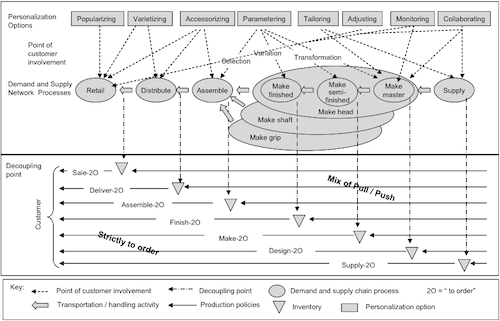Personalized Products and their Impact on Supply Chain Design
Experts from research and business alike argue that within the last decades consumers have grown to be a more demanding factor for supply chain management. At the same time manufacturing and supply chain strategies adapted to this development (from lean to agile, see Christopher and Towill, 2000).
But how are customer demands going to develop? Are we already seeing the decentralized manufacturing world, where everybody uses his own 3D printer to produce individual products on their desks? Probably not yet.
But at least for some industries product personalization is one big issues these days. Poulin et al. 2006 analyzes what options companies have to personalize products for their customers and shows the possible effects on supply chain design.
Personalization
From the literature the authors summarize their framework for product personalization. It consists of the following eight options:
| Personalization Option | Characteristics |
|---|---|
| Popularizing | Limited number of product to match a wide variety of customer needs, for those who want off-the-shelf products. Focus on evolving the popular product mix in line ith evolving customer needs |
| Varietizing | Extensive mix of products to satisfy almost all customer needs. Retailers pick those they want to offer off-the-shelf and rely on quick delivery from the distribution network for fast delivery of the others |
| Accessorizing | A limited set of core products matched with a wide array of accessories. Final assembly of accessorized products performed to order either by the user, the retailer or a fulfillment center |
| Parametering | Customer defines the desired product through the setting of parameters and the selection of options. He is guided through the specification process. Manufacturing is strictly to order |
| Tailoring | Product designed/engineered to customer needs. The customer is closely involved in the product realization process |
| Adjusting | Product adjusted to customer needs after usage. Distributed information systems capture customer feedback |
| Monitoring | Product is replaced by more adequate product as the customer needs evolve, ensuring continually a best-fit product. This involves regular and interactive customer feedback |
| Collaborating | Client is viewed as a collaborator with an open dialog. Expert field systems interact with clients, seeking to continually optimize client return |
Methodology
To gain insights on the effects on supply chain design the authors conduct a case study in the golf iron industry, where already now a high product variety is a standard. They build a systems model of the industry to improve understanding of the relevant factors and different clients.
After that they describe the deployment of each of the above mentioned personalization options within the industry. For example:
- Golf clubs can be parameterized using different coloring
- the tailoring option would be used if a customer asks for a different weight distribution in the cavity of an iron head to correct specific, personal miss-hits.
- Adjustments would involve the post sale process, where the iron is adjusted to specific needs
Effects on Design
In the following table the effects on supply chain design are listed.
The authors then visualize the effects of the customer involvement and differing decoupling points within the supply chain, effectively generating multiple supply chains for the different customer demands (see figure 1).
Conclusion
Personalized products are going to be the order winners of the future. The supply chain design has to adapt to these challenges and Poulin et al. gives a good start to change the supply chain accordingly.
Poulin, M., Montreuil, B., & Martel, A. (2006). Implications of personalization offers on demand and supply network design: A case from the golf club industry European Journal of Operational Research, 169 (3), 996-1009 DOI: 10.1016/j.ejor.2005.02.005
Christopher, M., & Towill, D. (2000). Supply chain migration from lean and functional to agile and customised Supply Chain Management: An International Journal, 5 (4), 206-213 DOI: 10.1108/13598540010347334










Add new comment